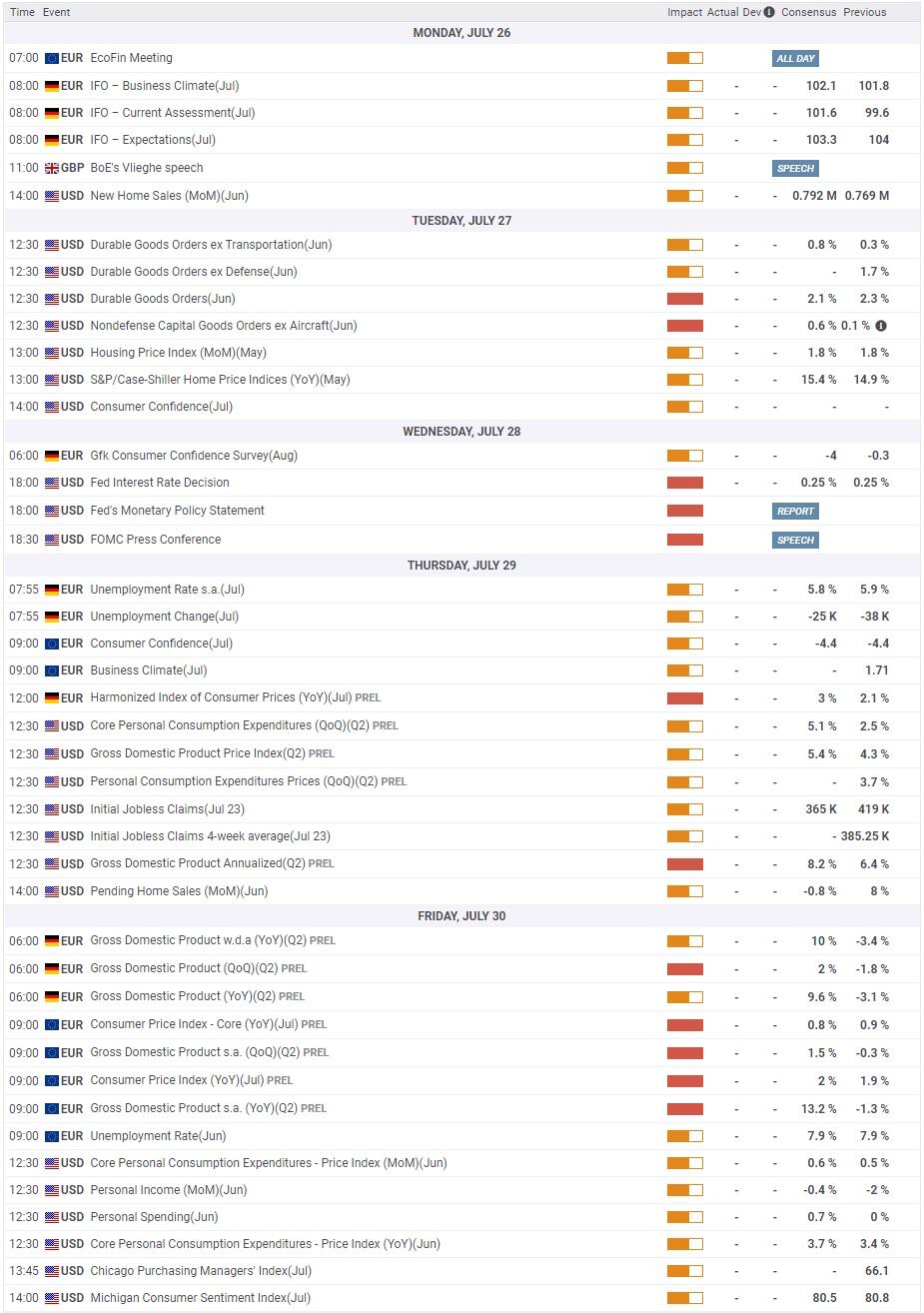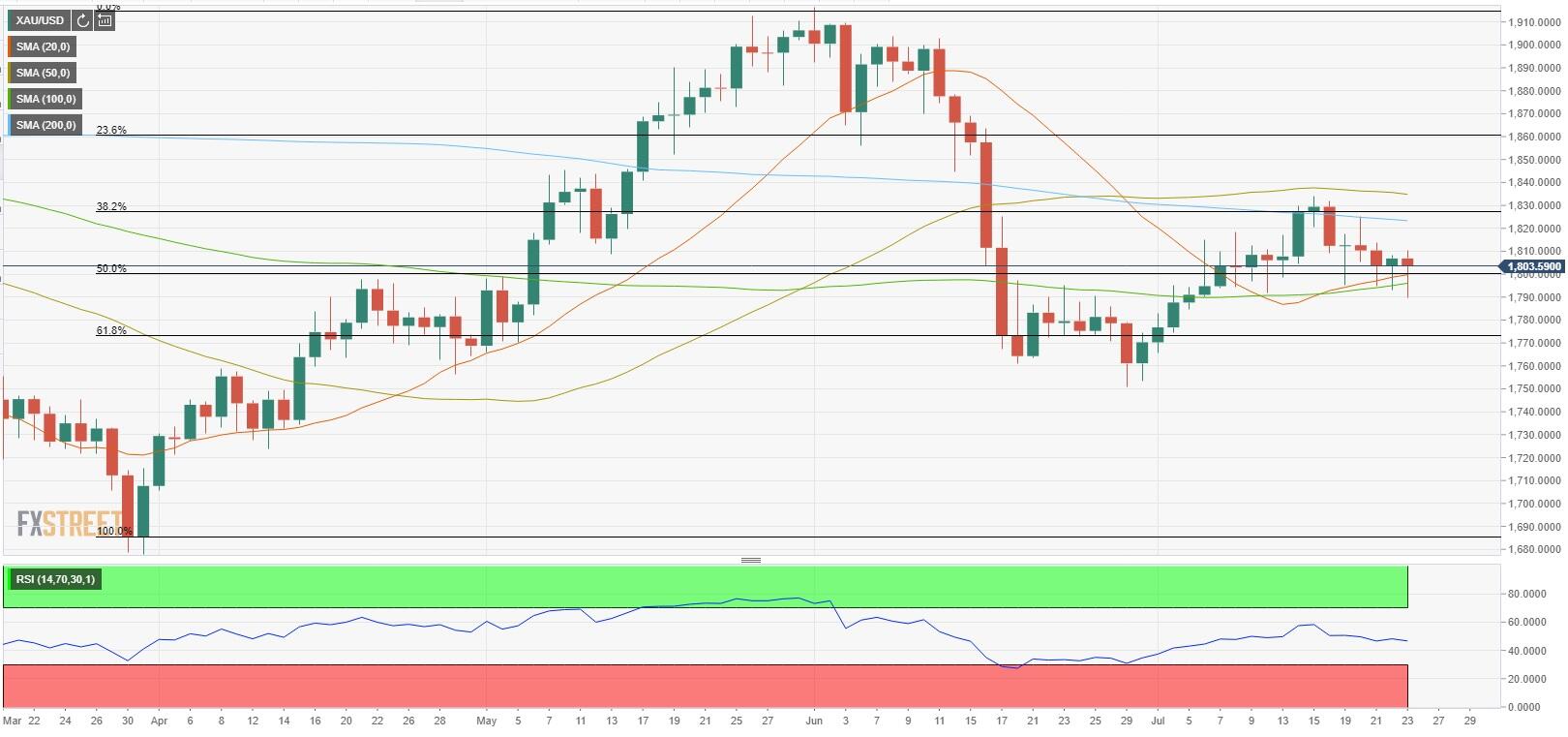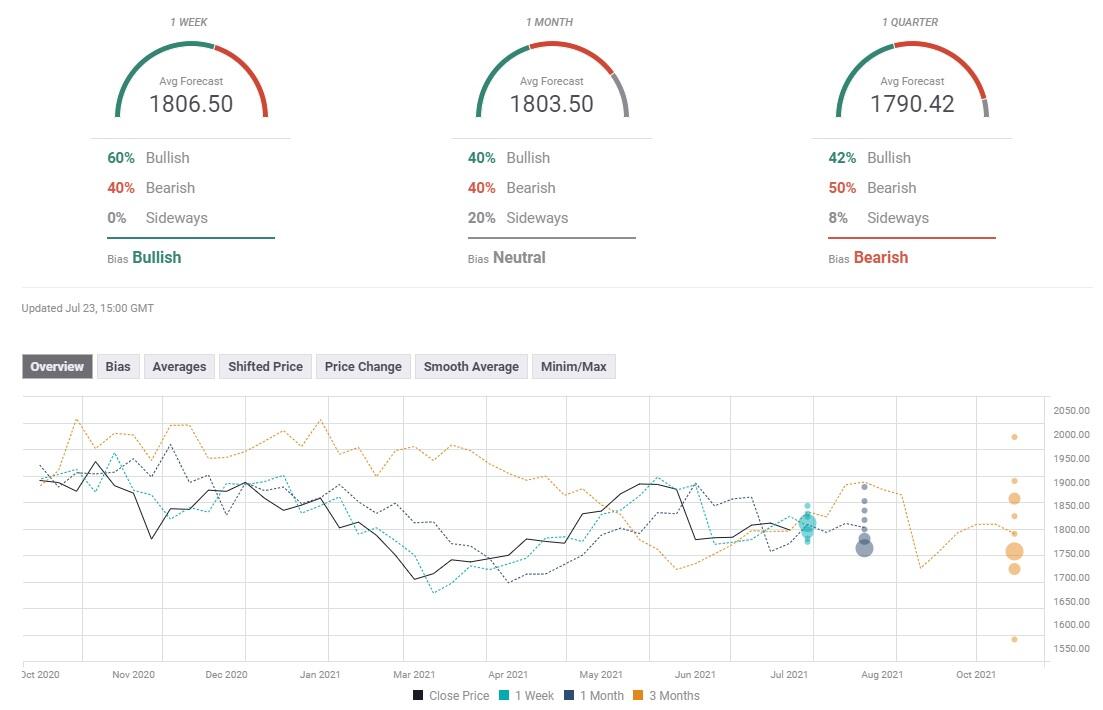Gold Weekly Forecast: XAU/USD bears await break below 100-day SMA at $1,796
- Gold closed near the lower limit of the weekly channel.
- Additional losses are likely if XAU/USD breaks below the 100-day SMA.
- FOMC meeting and US Q2 GDP data highlight next week’s economic calendar.
Following a four-week winning streak, the XAU/USD pair struggled to make a decisive move in either direction and fluctuated between key technical levels. After rising above $1,820 on Tuesday, gold turned south in the second half of the week but managed to close the week a little above the key 100-day SMA, which is currently located at $1,796.
What happened last week
In the absence of high-tier macroeconomic data releases and fundamental developments, risk perception remained the primary market driver earlier in the week. The sharp decline witnessed in Wall Street’s main indexes on Monday and Tuesday allowed the greenback to find demand. However, gold also capitalized on risk-off flows, suggesting that the precious metal is looking to recapture its safe-haven status and limited XAU/USD’s upside.
Although the USD lost its strength amid the improving market sentiment mid-week, XAU/USD continued to move sideways in its weekly range.
On Thursday, the US Department of Labor reported there were 419,000 initial claims for unemployment benefits in the US during the week ending July 17. This reading came in worse than the market expectation of 350,000 but was largely ignored by market participants. Other data from the US showed that Existing Home Sales increased by 1.4% on a monthly basis while the national median home price for existing homes increased by 23.4% from June 2020 to $363,000.
In the meantime, the European Central Bank (ECB) announced on Thursday that it left the interest rates unchanged on the main refinancing operations, the marginal lending facility and the deposit facility unchanged at 0.00%, 0.25% and -0.50%, respectively, as expected. In its policy statement, the ECB revised its forward guidance and said that it will allow a temporary overshoot of inflation before taking policy action. The ECB’s commitment to a dovish policy outlook weighed on the shared currency and helped the USD continue to outperform its rivals.
On Friday, the IHS Markit’s preliminary PMI reports revealed that the economic activity in the manufacturing sector continued to expand at a record-setting pace in July with the Manufacturing PMI rising to 63.1 from 62.1 in June. On a negative note, the Services PMI edged lower to 59.8 from 64.6 and fell short of analysts’ estimate of 64.8. Commenting on the data, “inflationary pressures and supply constraints – both in terms of labour and materials shortages – nevertheless remain major sources of uncertainty among businesses, as does the delta variant, all of which has pushed business optimism about the year ahead to the lowest seen so far this year,” said Chris Williamson, Chief Business Economist at IHS Markit.
Next week
Next week will be quite busy with regards to high-tier data releases. On Tuesday, June Durable Goods will be released from the US alongside the Conference Board’s (CB) Consumer Confidence Index. The University of Michigan’s (UoM) preliminary Consumer Sentiment Index for July showed a negative shift in consumer sentiment and a sharp increase in inflation expectations. A similar picture in the CB’s report is likely to provide a boost to the USD.
On Wednesday, the FOMC will announce its Interest Rate Decision and publish the Monetary Policy Statement. While delivering his prepared remarks at a congressional hearing earlier in the month, FOMC Chairman Jerome Powell said the job market was still a ways off from progress needed to begin the bond-buying taper. However, policymakers are expected to discuss the tapering plan going forward at next week’s meeting and a signal toward a reduction in asset purchases before the end of the year is likely to lift the greenback. Nevertheless, gold could stay resilient if a hawkish shift in the Fed’s policy outlook triggers a selloff in US stocks. On the other hand, the Fed could opt out to adopt a more cautious tone due to the uncertainty caused by the coronavirus delta variant and weigh heavily on the USD by hinting at a possible delay in tapering.
On Thursday, the US Bureau of Economic Analysis will release its initial estimate of the second quarter Gross Domestic Product (GDP) growth, which is expected to improve to 7.9% on a yearly basis from 6.4%. Finally, the Personal Consumption Expenditures (PCE) Price Index, the Fed’s preferred gauge of inflation, will be featured in the US economic docket on Friday. Annual Core PCE inflation is forecast to rise to 3.7% from 3.4% in June. A stronger-than-expected inflation reading could support the USD ahead of the weekend and vice versa.

Gold technical outlook
Gold’s near-term technical outlook remains neutral with a bearish bias as the price stays near the lower limit of the weekly consolidation channel. Additionally, the Relative Strength Index (RSI) indicator on the daily chart retreated below 50, suggesting that buyers are struggling to remain in control.
Nonetheless, sellers could wait for XAU/USD to make a daily close below $1,796 (100-day SMA) before looking to ramp up the bearish pressure. Below that level, $1,790 (Friday low) aligns as interim support ahead of $1,775 (Fibonacci 61.8 retracement April-June uptrend).
On the flip side, the 200-day SMA seems to have formed a tough resistance at $1,820. In case buyers lift the price above that hurdle, $1,830 (Fibonacci 38.2% retracement) and $1,835 (50-day SMA) could be seen as the next targets.
Gold sentiment poll
The FXStreet Forecast Poll points to a slightly bullish outlook in the near term with an average target of $1,806 on the one-week view. However, experts don’t seem to be expecting buyers to continue to dominate gold’s price as the average target retreats to $1,803 on a one-month view.



